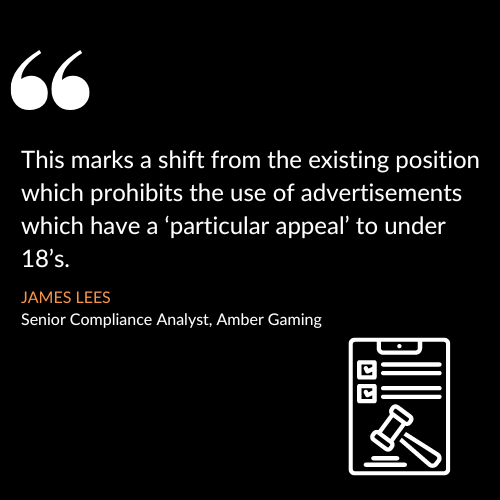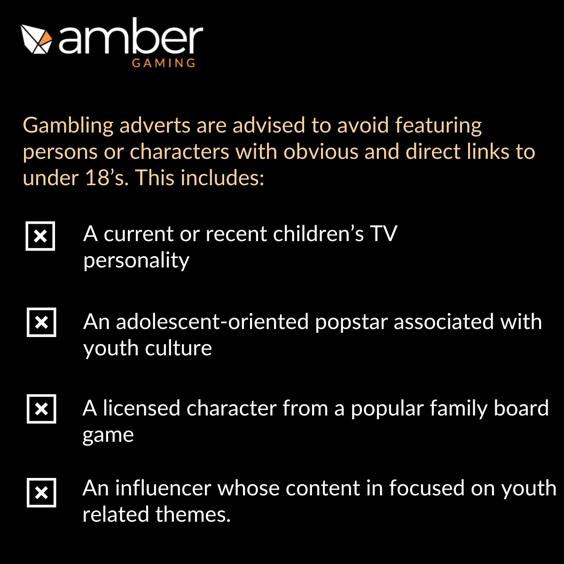By James Lees of Amber Gaming (Isle of Man)
The Advertising Standards Authority (“ASA”) recently announced that they would be introducing tougher rules for gambling advertisements, which will come into effect from 1st October 2022. These rules are intended to provide greater safeguards for young children and vulnerable people by restricting the use of high-profile individuals and imagery which would have ‘strong appeal’ to under-18’s. This marks a major shift for the advertising of gambling activity as the likes of Premier League footballers and reality TV stars will be prohibited in appearing in any gambling advertisements.
From 1st October 2022, any advertisement which is deemed to have ‘strong appeal’ to individuals under the age of 18 shall be prohibited, irrespective of its appeal to adults. This marks a shift from the existing position which prohibits the use of advertisements which have a ‘particular appeal’ to under 18’s.
An advertisement with particular appeal to under 18’s includes content that is likely to appeal to under 18’s more than those over the age of 18. Should the content be likely to appeal to both under 18’s and adults equally, they are unlikely to breach the rules.
Under the new strong appeal rules however, whether the content appeals to adults is irrelevant if it is deemed to unduly attract those under the age of 18.
The new requirements shall apply equally to broadcast and non-broadcast advertising under the Broadcasting Committee of Advertising Practice (“BCAP”) and Committee of Advertising Practice (“CAP”) rules.

Determining the likely appeal of marketing communications to specific demographics is often complex and to a large extent, subjective. The ASA shall apply the strong appeal test to specific elements of the advertisement, as well as the general impression given by the advert in context. This test shall include analysis of under 18’s in general, as well as specific age groups within the under 18 demographic.
Operators are required to undertake a robust assessment of their advertisements’ likely appeal to children prior to publication and should exercise caution where they are unable to form a conclusion of its likely appeal. Whilst there is no specific threshold where an advertisement may become of strong appeal to children, anything which appeals to more than 5% of children is likely to raise questions from the ASA.
There are many sports and activities which are likely to have significant appeal to under 18’s, such as football and video games. The advertisement for betting on such activities is, in principle, banned outright due to their inherent strong appeal to under 18’s. There are, however, applicable exemptions that apply to ensure that a balance is maintained between the protection of minors and an operators’ right to advertise licensed products.
Advertisements may therefore be exempted:
It remains prohibited for anyone who is, or appears to be, under 25 years old to feature in a significant role in any gambling advertisement. In addition, advertisements must not feature any person or character whose example is likely to be followed by under 18’s or has a strong appeal to those under the age of 18.
Gambling advertisements may use persons or characters to promote their product, provided that they can satisfy the exemption criteria. It is important to understand the type of person or character used within the advertisement to determine its’ likely appeal to under 18’s.
Persons or characters fall into one of the following categories:
Personalities, brand ambassadors and licensed characters are assessed both on their profile and relevance outside of the specific advertisement, as well as their behaviour within the advertisement.
Characters played by actors and brand-generated characters who have no profile outside of the context of the advertisement are judged solely on their appearance and behaviour within the advertisement.
To determine whether a person or character has particular appeal to minors, consideration needs to be given to:

Operators are required to assess the level of appeal of an individual or character regardless of whether they have an obvious and direct link to under 18’s. Advertisers are encouraged to use as many data sources as possible to create a picture of the relevant audience(s) to which they appeal.
Some of the considerations which an operator should have consideration for include:
Some examples where a person or character would meet the strong appeal threshold and therefore would not be acceptable within an advertisement include:
Some examples where a person or character would be less likely to have a strong appeal to under 18’s include:
There are several examples of sports which would be considered adult-oriented and therefore can be deemed to have a low appeal to children. The ASA’s guidance provides that Sports like horse racing, greyhound racing, darts, snooker, boxing, motorsports and golf are more adult-oriented and unlikely to be of inherent ‘strong’ appeal.
During a webinar held by the ASA, further examples were provided of ex-sportspeople featuring in gambling advertisements.
Ronnie O’Sullivan is a middle-aged snooker player who is unlikely by virtue of the sport he participates in, is not likely to be of strong appeal to children. Ronnie O’Sullivan is however a very popular personality online and TV and operators must therefore carefully consider how he resonates with children when assessing if he as an individual has strong appeal to children.
In another example, ex-footballer Michael Owen was raised as an individual who previously would have been considered as having a strong appeal to children but has since retired and does not have a strong social media presence amongst children. The bulk of his work is now in TV punditry, and he is also involved in horse racing. Michael Owen did however recently appear on popular TV show ‘The Masked Singer’ which does have strong appeal to children. Based on this association alone, Michael Owen would be deemed to have a likely strong appeal to children.
The second element to the ASA’s assessment on whether an advertisement has strong appeal to minors is how the person or character appears and behaves. A character who does not appeal strongly to under 18’s through his appearance may nonetheless have strong appeal to children through their behaviour and characteristics.
Similarly, a person or character who does not appeal to children through his behaviour may appeal strongly to under 18’s through their appearance.
Cartoons, puppets, or other animated characters created by marketers should not be used to portray characters that an audience is likely to identify as under 18. This would include the use of exaggerated features, colourful characteristics, or resemble soft toys.
In a move to increase the restrictions in place from the existing ‘particular’ appeal rules, characters such as Santa Claus, the Easter Bunny or the Tooth Fairy are prohibited from appearing in advertisements from 1 October 2022. Under the strong appeal rules, the ASA considers such characters to appeal to under 18’s no matter how they are stylised.
The ‘particular’ appeal criteria has previously permitted the use of Little Red Riding Hood and Hansel and Gretel in advertisements where they had been characterised in a manner that was unlikely to be of appeal to children. Such characters will be prohibited under the new strong appeal rules.
Characters played by actors should similarly not be presented in a way which is likely to be of strong appeal to under 18’s. This is in addition to the requirement that they should not be, or appear to be, under 25.
In assessing the strength of the appeal, the ASA shall consider the characters physical appearance, including clothing jewellery, body art and hairstyles.
Advertisements must avoid featuring a person or character where their behaviour is likely to have strong appeal to under 18’s.
The ASA will assess behaviour of persons and characters featuring in advertisements in line with the following:
As well as the use of people and actors who could be considered to have strong appeal to under 18’s, there are several other considerations to ensure that an advertisement does not have strong appeal.
This includes:
As under the particular appeal rules, adverts which are targeted in a way that can remove under 18’s from being exposed to advertising content which would otherwise be prohibited are exempted from the strong appeal rules.
This exemption applies to media environments that for all intents and purposes remove under 18’s from the audience of their advertising. These include:
The ASA will however expect operators to demonstrate that their systems used to restrict access to advertisements that would have strong appeal to children are robust. Accepted age verification methods for Gambling Commission licensed operators would be considered as satisfactory.
Where it is not possible to be sufficiently certain that advertisements shall not reach those under the age of 18, and those advertisements would be considered as having a strong appeal to under 18’s, then the advertisement must not be published.
Operators are advised to err on the side of caution with all marketing material associated with the advertisement of gambling related activity.
What do I need to do to prepare?
With the 1st October deadline fast approaching, operators should now be reviewing, assessing and implementing the appropriate measures, frameworks and training within the organisation. These include the following:
Our experts can provide guidance on how you and your staff can prepare for and look ahead to this and further regulatory updates with our training and compliance frameworks. If you would like to find out more, get in touch with our team below:
 Contrast
Contrast
 Text size
Text size